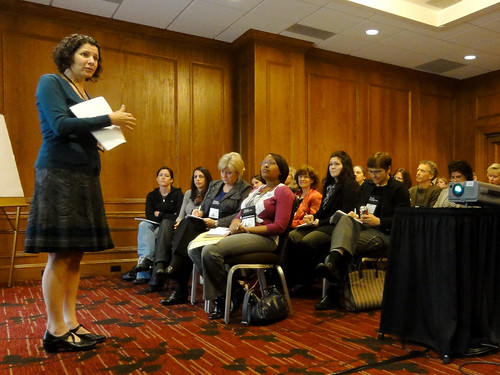So. My boss and I went to St. Louis for five days and four nights for POD 2010. Here are some notes on the whole experience.
Perhaps most noteworthy, from a strictly personal perspective, was the fact that I co-presented at not one but two sessions. The first was called “Investigating Our Blind Spot,” which I co-presented with my boss to a packed room.
I was proud of this because it was at least partly my idea. It grew out of a conversation we had on the way back from POD 2009. Here’s an excerpt from our proposal, which I wrote all by my very own self.
As faculty developers, we often rely on chronic participants to assess our programs, “frequent flyers” who see the value of our offerings and keep coming back for more. These faculty provide valuable insight into what we are doing right and how we can improve our services. However, the limitations of such an approach are self-evident. Chronic participants present an incomplete picture at best, and at worst they may contribute to a narcissistic cycle of self-admiration wherein fundamental assumptions are rarely challenged. As a result, even while we learn to better serve our most ardent supporters, our effectiveness across the institution may be limited.
If chronic participants act as a mirror, reflecting our own values, what might we learn by looking beyond the mirror, into our “blind spot”? Faculty members who never (or very rarely) take advantage of development opportunities can provide information that is just as useful in setting the direction of our offerings. Yet most of our knowledge about these nonparticipating faculty is anecdotal or speculative. Who are these faculty? Why don’t they participate, and how might we better serve them as faculty developers?
We conducted an investigation into these questions over the summer. I can’t take credit for the research. I had no clue how to proceed, but it was right up the Boss Lady’s alley. It was an educational experience for me. I won’t get into all the details here, but the turnout for the session indicated that the concept resonated with others. Perhaps a publication will come out of it.
On a truly bizarre note, after the “Blind Spot” session, I was asked for my autograph by a ROX fan. No lie.
The other session I co-presented was “Uncovering the Heart in Higher Education.” I mentioned my involvement with this previously. Here’s the description.
Beneath the frenetic pace of the academy and its superficial busyness, many of us feel an emptiness and absence of purpose. Surveys of faculty in the Spirituality in Higher Education project confirm the underlying fragmentation in the lives of faculty. This session extends a conversation ongoing at the conference since a symposium cosponsored by POD, the California Institute of Integral Studies and the Fetzer Institute in October 2008. Participants will experience aspects of the new academy we imagine including silence, mind-body practices and sharing personal worldviews. The session will also provide opportunity for exchange of promising faculty “heart” development practices on campuses.
It was a fun session. We took a moment of silence to contemplate some serious questions, we did a yoga breathing exercise, we broke into dyads to discuss our fundamental worldviews. We also shared what we were doing to promote this work on various campuses. That was my contribution; I discussed our modest efforts here at the University, which I have also written about here over the last few months.
As for sessions at which I did not present, the most interesting one I attended was called “Gateway to the East? Professional Renewal Using the Chakra System” by Michele DiPietro. This was fascinating to me because although I’ve heard of chakras for decades I know almost nothing about them, and certainly I’ve never thought about them as a framework for professional development.
My golden shining moment came during a plenary session by Kristen Renn of Michigan State University, titled “Intersections of Identity, Teaching, and Learning: LGBT Issues and Student Success.” At one point she talked about the concept of microaggressions, a term coined by Chester Pierce in the 1970s. These are everyday verbal comments or other behaviors that fall short of outright physical aggression, but serve to assert and maintain the dominance of a majority group over various minorities — basically little ways of putting other people down and perpetuating inequalities. When Renn talked about strategies for supporting students who might feel marginalized, she talked about small positive behaviors intended to indicate solidarity. These might be considered the opposite of microaggressions, but Renn complained that she didn’t have a word for such behaviors, and she invited suggestions from the audience during the comment session after her talk. When the time came I stepped up to the mic and offered my idea: microaffirmations. I got a big round of applause for this, and received continuing kudos throughout the rest of the conference. One person even mentioned how much she liked my voice.
Of course, there’s nothing new under the sun. It turns out this term was already coined by Mary Rowe in 1973. But I’ll happily take all the credit.
I don’t think POD 2010 will prove as transformative for me personally as POD 2009 was. How could it be? This is not a real disappointment nor a criticism, just a statement of fact. But only time will tell.
Footnote 1: Last year, one of the highlights of my trip to Houston was a pilgrimage to Anvil for some of the best cocktails I’ve ever had. This year, on a hunch, I googled “anvil houston cure new orleans” (Cure being the local analog to Anvil) and I found a list from Bon Appétit of “The Top 10 Best New Cocktail Bars” in the country. And sure enough, one of them was in St. Louis — Taste by Niche. “Mixologist Ted Kilgore and local celeb chef Gerard Craft pair their talents: The Grey Fizz (gin, Earl-Grey-infused vermouth, lemon, egg whites) sublimely complements pig-shaped cookies with bacon cream.” Yum. I was excited to go there, but, alas, it didn’t work out. At the last minute the Boss Lady and I were joined by an old friend of hers. I knew Taste is an incredibly small space; we’d probably have to sit at the bar, and that’s awkward for a group of three. So instead we opted for my second choice, The Royale, which got a good review in the New York Times. Yet that ended up being something of a fiasco as well, since it was too crowded for us to sit inside. We ended up on the back patio, but it was too damn cold to be comfortable. As for the cocktails, they were indeed well-made; I think I had four. But there was nothing on the list that really floored me the way Anvil did, no jaw-droppingly amazing drinks, no rare ingredients or mind-bogglingly innovative combinations. I should have realized the inclusion of vodka cocktails on the menu was a sign I’d be disappointed. I feel bad saying I was “disappointed” since they were making plenty of classics with reassuring competence. Sadly, I seem to have reached the point of being extremely hard to please in the cocktail department. If I can make it in my kitchen, why bother? Perhaps the chilly patio dampened my enthusiasm as well. The ultimate irony — it turns out Boss Lady’s old friend is a teetotaler. But I was glad they goat a chance to catch up with one another. Also I snapped this photo of the heater, which I think looks like an E.L.O. album.
So it wasn’t a complete loss. But I sure wish I’d made it to Taste by Niche.
Footnote 2: I’d never flown Southwest before and that was a treat. Amongst other zaniness I got to hear a flight attendant sing “Evergreen” as we descended to Houston. Boss Lady was horrified but I thought it was sweet.
Discover more from b.rox
Subscribe to get the latest posts sent to your email.


Southwest is my airline of choice. The employees seem to be having fun, and it is one of the most forgiving airlines as far as itinerary changes too. Luv them.
Years before opening Pegu Club in NYC, Audrey Saunders created the Earl Grey MarTEAni for the Hotel Carlyle’s Bemelmans Bar. Since then, there have been many riffs on her cocktail (such as the Grey Fizz), but the original is still sublime:
Earl Grey MarTEAni
3/4 ounce fresh lemon juice
1 ounce simple syrup (1:1 sugar-to-water ratio)
1 1/2 ounce Earl Grey tea-infused Tanqueray gin
1 egg white
Garnish: lemon twist
Measure all the ingredients into a mixing glass. Add ice, and shake hard to a 15-second count. Strain into a chilled martini glass, half-rimmed with sugar. Garnish with a lemon twist.
– – – – – – – – – – – –
Earl Grey tea-infused Tanqueray gin
1 750 ml bottle of Tanqueray gin (for its flavor and high proof)
4 tablespoons loose Earl Grey tea
Measure tea into bottle. Cap and shake, and let sit at room temperature for exactly 2 hours. If the tea is allowed to steep any longer, the gin will be overly tannic. Strain through a fine sieve or coffee filter into a bowl. Do not press down on tea to extract excess gin, as this will make the gin bitter. Rinse out bottle to remove loose tea, and pour infusion back into clean bottle. Will store indefinitely refrigerated.